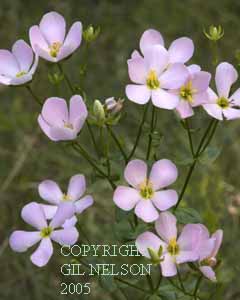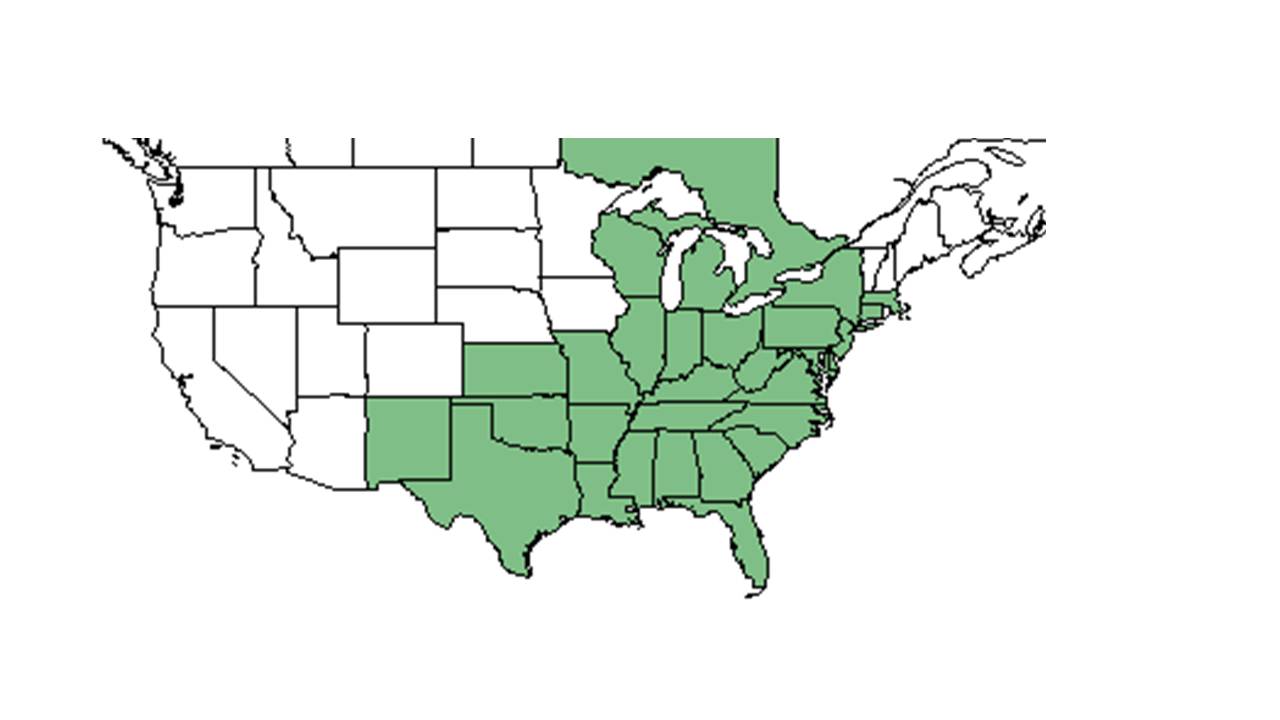Sabatia angularis
| Sabatia angularis | |
|---|---|

| |
| Photo taken by Gil Nelson | |
| Scientific classification | |
| Kingdom: | Plantae |
| Division: | Magnoliophyta – Flowering plants |
| Class: | Magnoliopsida – Dicotyledons |
| Order: | Gentianales |
| Family: | Gentianaceae |
| Genus: | Sabatia |
| Species: | S. angularis |
| Binomial name | |
| Sabatia angularis (L.) Pursh | |

| |
| Natural range of Sabatia angularis from USDA NRCS Plants Database. | |
Common names: Bitter-bloom, Common Marshpink, or Rosepink (Nelson 2006).
Contents
Taxonomic notes
Description
"Glabrous, perennial or annual herbs with erect or ascending stems. Leaves opposite, entire, sessile. Inflorescence terminal, cymose. Calyx 5-13 parted, lobes united at bae, those of first flowers longest, smaller on later flowers; corolla rotate white or pink with yellow eye, lobes 5-13, tube becoming membranous and persistent around the capsule. Capsule ovoid to ellipsoid; seeds small, alveolate." - Radford et al 1964
"Annual, rhizomes absent. Stems freely branched, quadrangular, usually winged, 2-8 dm tall. Basal leaves absent or present at anthesis; stems leaves ovate to ovate-lanceolate, 1.5-5 cm long, 1-4 cm wide, acute. Inflorescence paniculate, 1-2.5 cm broad, to 3.5 dm long, branches opposite. Calyx lobes 5, linear to narrow lanceolate, 0.7-1.5 cm long; corolla lobes pink, rarely white, oblanceolate, 1.5-2cm long, 0.6-1 cm wide; filaments 3-5 mm long; stigmas and style 4-6 mm long. Capsule ellipsoid, 6-10 mm long, angles not winged; seeds blackish brown, 0.4-0.5 mm long." - Radford et al 1964
Distribution
It is found in upland forests, forest edges, glades, and meadows. It is mostly an upland species, but sometimes will be seen along the edges of upland streams (Nelson 2006).
Ecology
Habitat
In the Coastal Plain in Florida and Georgia, S. angularis can be found in floodplain forests, hardwoods, annually burned upland pine woodlands, annually burned savannas, upland pines, and limestone glades. Associated species include Schoenus nigricans, Rhynchospora divergens, and Juniperus (FSU Herbarium).
Phenology
It blooms from July to August (Nelson 2006).
Conservation and management
Cultivation and restoration
Photo Gallery
References and notes
Florida State University Robert K. Godfrey Herbarium database. URL: http://herbarium.bio.fsu.edu. Last accessed: July 2015. Collectors: Robert K. Godfrey, Roy Komarek, R. A. Norris, Richard R. Clinebell II, J. M. Kane, Loran C. Anderson. States and Counties: Florida: Calhoun, Jackson, Leon. Georgia: Grady, Thomas. Compiled by Tall Timbers Research Station and Land Conservancy.
Nelson, Gil. Atlantic Coastal Plain Wildflowers: A Field Guide to the Wildflowers of the Coastal Regions of Virginia, North Carolina, South Carolina, Georgia, and Northeastern Florida. Guilford, CT: FalconGuide, 2006. 86. Print.
Radford, Albert E., Harry E. Ahles, and C. Ritchie Bell. Manual of the Vascular Flora of the Carolinas. 1964, 1968. The University of North Carolina Press. 838. Print.